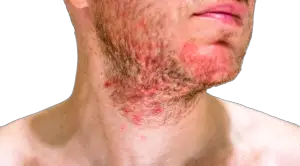When my seb derm rash first got so bad that I went looking for a diagnosis, no doctor could tell me what it was. Turns out there is no blood test or biopsy that will magically tell you what a skin rash is from.
When it comes to rashes, the way to the root cause is through a thorough history and most doctors don’t have time for that.
Plus, unlike eczema, psoriasis and even rosacea, there’s not much around about what is seborrheic dermatitis. That’s because no one is sure about what causes it and triggers it off.
That’s why it’s left to us seb derm sufferers to take matters into our own hands. Let’s start with learning more about the enemy so we can beat it at its own game.
If you prefer to listen, check out this recording:
- What is seborrheic dermatitis?
- What seborrheic dermatitis is not
- How is seborrheic dermatitis diagnosed?
- Signs and symptoms of seborrheic dermatitis
- What is the cause of seborrheic dermatitis?
- What are the risk factors for seborrheic dermatitis?
- What triggers seborrheic dermatitis?
- How to treat seborrheic dermatitis
- Prognosis for seborrheic dermatitis
If you would rather read, let’s get on with it:
What is seborrheic dermatitis?
In a nutshell, seborrheic dermatitis is a chronic skin condition that affects mainly the scalp, but can also affect other areas with high numbers of sebaceous glands, such as the face, neck and upper chest.
In an infant, you’ll know seborrheic dermatitis of the scalp as ‘cradle cap’ and in everyone else, it’s well known as dandruff. If you didn’t know this, don’t feel bad. I didn’t either until I got seb derm on my face and did some digging.
Seb derm is traditionally thought of as incurable with flare ups and remissions throughout your lifetime (I tell you how you can put it into a prolonged remission here).
What seborrheic dermatitis is not
- It’s not contagious
- It’s not an auto-immune condition (it’s a hyper-reactive immune reaction, there’s a difference)
- It’s not a fungal infection
- It’s not an allergic reaction
- It’s not caused by food (not directly anyway)
How is seborrheic dermatitis diagnosed?
There is no blood or skin test that can prove seborrheic dermatitis. To diagnose seb derm, a health care provider will need to look closely at your rash, its pattern of distribution, and thoroughly discuss your symptoms and the events leading up to it.
Signs and symptoms of seborrheic dermatitis
Seborrheic dermatitis is a clinical diagnosis based on the location and appearance of lesions. Seb derm typically presents as flaky, greasy, erythematous patches on the scalp, nasolabial folds, ears, eyebrows, anterior chest, or upper back.

The rash can often cause itching and burning sensations on the affected areas. You may also experience crusting and weeping. These signs can vary in severity from person to person.
Diagnosis of seborrheic dermatitis can be difficult in patients with darker skin, but the same principles apply. People with darker skin tones may also experience discoloration or hyperpigmentation in the affected areas.
I take a deep dive in What characterizes seborrheic dermatitis?
What is the cause of seborrheic dermatitis?
The main causes of seb derm is 5 fold:
-
Malassezia
This yeast is found naturally on the skin and studies have found a higher number of Malassezia on skin affected by seb derm. Get to know our friendly neighbourhood yeast in this article.
-
Skin microbiome imbalance
When the micro-ecosystem of bacteria and fungi on your skin is shaken up, it can encourage Malassezia overgrowth.
-
Oily skin
Seb derm rash has a predilection for areas with high sebaceous gland activity, i.e oily skin. This makes sense because Malassezia thrives on oil. (find out if eating oily food makes it worse)
-
Hyper-reactive response to Malassezia
Your immune system is more sensitive to the presence of Malassezia and its byproducts and unleashes a fierce infammatory response to it.
-
Damaged skin barrier
It’s a vicious cycle. Malassezia penetrates the skin barrier, causing an inflammatory response which destroys the barrier further, allowing Malassezia to dig deeper. Find out more about the fascinating link between skin barrier and seb derm here.
I take a deeper dive into these 5 factors here: Why do I have seborrheic dermatitis (and not them)?
What are the risk factors for seborrheic dermatitis?
There are many conditions that are thought to increase your risk for seborrheic dermatitis. At the heart of it, any condition that causes stress to your immune system, affect your skin barrier and microbiome, and increases sebum production (see causes above) can trigger the start of a life-long relationship with seb derm.
- Obesity
- Nervous system disorders including Parkinsons disease
- Traumatic brain injury
- Stroke
- HIV/AIDS
- Alcohol dependence
- Eating disorders
- Depression
- Epilepsy
Certain medications can also increase your risk:
- Lithium
- Buspirone
- Haloperidol
- Chlorpromazine
- Cyproterone acetate
What triggers seborrheic dermatitis?
Seborrheic dermatitis can be triggered by almost anything and is very personal. Humidity, stress and fatigue are my main triggers but yours could be very different.

Other possible triggers include dry climate, cold weather, anxiety and certain foods.
Take a look at this list and see if any of them could be your seb derm trigger.
How to treat seborrheic dermatitis
Sadly, due to state of healthcare now a days where there’s a limit to how much time a doctor can spend with each patient, most doctors don’t dig deep enough to get to the root cause. Even when the rare enlightened one diagnoses seborrheic dermatitis, treatment is often aimed superficially with creams.
Topical treatments for seborrheic dermatitis work by decreasing inflammation, removing scale, and targeting yeast. If you could only have one treatment, choose an anti-fungal. This can be a cream like clotrimazole for your skin and an anti-fungal shampoo like Nizoral for your scalp.
Topical treatments are amazing and very important to treat seborrheic dermatitis when it is present. However, the only way to prevent seb derm from coming back lays with tweaking your lifestyle so you’re boosting your immune system, protecting your microbiome and skin barrier, as well as avoiding triggers.
For a complete list of medications, creams and home remedies for seb derm, check out The Ultimate Guide to Seborrheic Dermatitis Treatment.I’m quite proud I put it all together. Let me know if there is anything I missed.
Prognosis for seborrheic dermatitis
Once you know that you’re dealing with seborrheic dermatitis and institute the right treatment, the prognosis is really good. Your rash could disappear within days. However, there is a good chance that it can return. This is especially so during the early days of treatment, when you haven’t fully figured out a regimen that works for you and avoiding all your triggers.
 Check it out on Amazon
Check it out on Amazon
Pingback: The Ultimate Guide to Seborrheic Dermatitis Treatment
Pingback: Can seborrheic dermatitis spread? How do I stop it?
Pingback: Is Clotimazole The Best Anti-fungal Cream For Seb Derm? (08/10/2023)
Pingback: seborrheic dermatitis eyelids
Pingback: seborrheic dermatitis vs eczema
Pingback: seborrheic dermatitis hairline
Pingback: What characterizes seborrheic dermatitis?